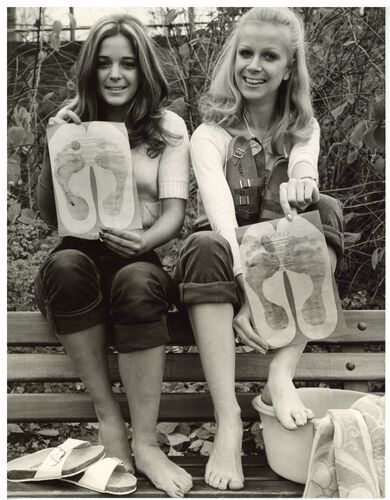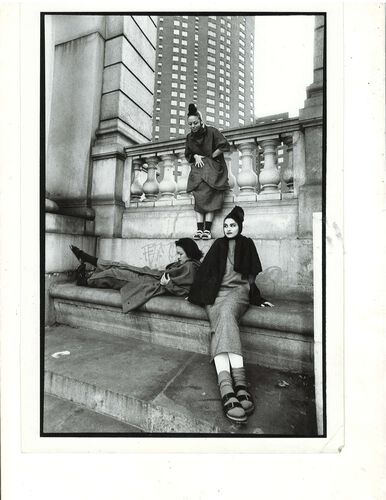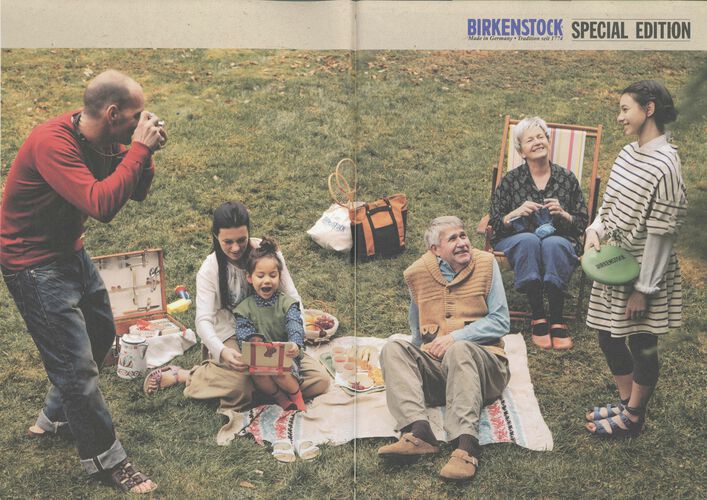




A FOOTWEAR REVOLUTION
From experimentation to counter-cultural symbolism, this is how BIRKENSTOCK helped the world walk as nature intended.
EVERY REVOLUTION NEEDS A SPARK
The shoemaking craft was handed down from one generation to the next before Konrad Birkenstock registered BIRKENSTOCK as a limited enterprise in 1897. Konrad was just 24 years old at the time, but he had already worked as an apprentice for years.
The young Birkenstock wasn’t just interested in maintaining the family trade — he was also an innovator with a fresh perspective on footwear, paying great attention to the anatomy of the foot. And as time would tell, he wasn’t alone in his thinking.

The end of the 19th century saw the rise of the Lebensreform (life reform) movement in Germany and Switzerland. Its proponents believed in living according to nature — rejecting materialism and what they saw as the unnatural constraints of the modern world. One such proponent, Albert Hoffa, published a booklet titled “Der menschliche Fuss und seine Bekleidung” (“The Human Foot and its Clothing”) in which he contrasted the “unspoiled” state of the foot with the damage that resulted from wearing inappropriate footwear. His ideas intrigued shoemakers around Germany and inspired them to experiment with designs that more closely resembled the natural form of the human foot.
Enter young Konrad. He decided to broaden the reach of his orthopedic experiments by creating an insole that could be combined with his anatomical last (the wooden molds around which shoes are constructed) to create what he termed “health footwear”. Experiments, however, take time.
THE HIGHS AND LOWS OF FINDING BETTER SUPPORT
Seven years later, in 1909, Konrad Birkenstock began using the term Fußbett (footbed) in advertising for two of his products. These ergonomic designs bound into existing shoes and shaped to support the foot, promoting physical well-being. The Fußbett design was constructed out of cardboard, mixed with tar or with rubber, and later parts cork and plastic were added to decrease the weight of the insole itself.
In fact, Konrad spent more than ten years tinkering with the material mix for his flexible insoles. This focus was not without its costs. He was so committed to these experiments that he neglected the commercial side of his business, and his family fell into financial trouble. This forced them to move from Frankfurt am Main to Friedberg, Germany in 1915, where Konrad continued to work developing insoles, assisted by his wife Elisabeth and his eldest son Carl.
Following the outbreak of World War I, Konrad worked in the orthopedics department at Friedrichsheim Hospital after narrowly avoiding service on the frontlines. During his time there, he was able to intensively study foot defects and how to treat them. This experience helped him become more confident in the superiority of his insoles for remedying orthopedic ailments over the metal insoles used in the medical field during that time.
These ergonomic designs, shaped to support the foot in a way that promotes physical well-being, paved the way for the development of his son Carl’s insole design. But as the Birkenstocks soon found, function alone wouldn’t change the shoemaking world. Form also mattered.
FROM BAUHAUS TO BRUTALISM TO… THE DOCTOR’S OFFICE?
The enduring influence of Bauhaus continues to leave an unmistakable mark on the design we use in our everyday lives. With the movement's belief that the aesthetics and form of an object or product should be guided by its usefulness, it is no surprise that the Birkenstocks were drawn to the Bauhaus.
In 1936, Carl was guided by the Birkenstock legacy and likely influenced by the Bauhaus movement to design what he termed the ‘Ideal Shoe’. While the concept would allow for the best-fitting shoe possible for customers (with insoles naturally adapting to an individual’s feet) the execution of the design needed multiple variations of shoe sizes (roughly nine variations, rather than one modern-day size) to be kept as inventory for those looking to sell the invention. (Not ideal, it turns out. More on this in a bit).
The arts continued to inspire — this time Carl’s son, Karl Birkenstock. Brutalism’s influence reached far beyond architecture in the 1960s, making its presence known in all areas of design and culture, including the Original BIRKENSTOCK-footbed sandal with a standardized integrated footbed. But like with art, taste in fashion can be subjective.
An icon in the making
With BIRKENSTOCK’s 200th anniversary in shoemaking tradition approaching in 1974, Karl Birkenstock set about designing a new sandal to mark the milestone. His aim was to design a more breathable alternative to the thick-strapped ZÜRICH, but one that would keep the foot in a stronger hold against the footbed than the single-strapped MADRID. The resulting ARIZONA (then called Geschlossenes Modell), which had what looks like a chunky double strap (a re-opened thick-strapped ZÜRICH) proved a particular hit in California where its unembellished practicality and gender-neutral aesthetic appealed to the ideals of the burgeoning hippy movement. Today it stands as BIRKENSTOCK’s best-selling design, with its appeal stretching far beyond the countercultural groups that initially helped propel the brand to new heights in the US. “The wardrobe staple still permeates fashion, culture, and Hollywood as it has done decade after decade,” wrote Daisy Shaw-Ellis in a 2023 article for Vanity Fair.
The conception of the ARIZONA followed a time-tested formula for creating design icons. From the Chanel suits that allowed women the freedom of movement to go out and work, to the weather-proof Burberry trench coats that were developed to withstand harsh British winters, history has shown that form has often combined with function when it comes to zeitgeist-shaping apparel.

SANDALS AS A SYMBOL
The 1960s were years of social upheaval in West Germany. The young generation rebelled against the “establishment” and protested against staid sexual morality and, soon, protest culture was unified by a specific style of dress that sought to stand out provocatively from prevailing fashion habits. This was most notably the case with Yves Saint Laurent, who unveiled his first pantsuits for women in 1967. That same year, members of Kommune 1 (Germany’s first left-wing radical commune) were photographed standing before the Berlin House of Representatives wearing sandals. They were being questioned about their role in protests surrounding the Shah of Persia’s visit to West Berlin and the choice of this informal footwear seemed to make a provocative mockery of the occasion and the officials involved.
The sandal was seen as a “shoe for all,” allowing men and women to move away from heteronormative concepts of dress. The design was simple, and the materials used for the sandals included neither the ornaments and fabrics predominantly used for women’s footwear, nor the smooth, black leather traditionally used for men’s shoes. Decades later, BIRKENSTOCK’s countercultural style only grew.
Since BIRKENSTOCK sandals arrived in Australia in 1992, the queer community has been early adopters of the footwear. For Australia’s lesbian community, the company’s uber-practical footwear flew in the face of the feminine ideals that the fashion industry was upholding by marketing skirts, dresses, and high heels to women. “They are the ultimate anti-fashion shoe,” Dr Emily Brayshaw, an Honorary Research Fellow at University of Technology Sydney’s Faculty of Design told BIRKENSTOCK. “What better shoe to kick the patriarchy in the balls in?”
What better shoe to kick the patriarchy in the balls in?
IN THE NAME OF COMFORT

When the outbreak of the coronavirus pandemic struck in 2020, countries around the world went into lockdown and millions of people were confined to their homes. This new reality caused a fundamental shift in how people chose to dress, with comfort becoming the number one priority. It was a switch that helped buoy BIRKENSTOCK sales worldwide, with the ARIZONA sandal becoming the most popular item on global fashion search platform, Lyst. “The humble BIRKENSTOCK has become fashion’s great equalizer during quarantine,” wrote Alice Newbold in British Vogue.




